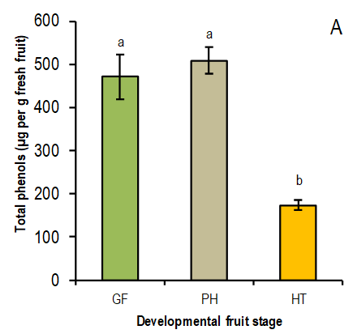Efecto de fosfitos en el contenido de fenoles totales y ácido clorogénico en el patosistema durazno-Monilinia fructicola
DOI:
https://doi.org/10.31285/AGRO.25.404Palabras clave:
podredumbre morena, Prunus persica, inductores de resistenciaResumen
Monilinia fructicola es un patógeno fúngico responsable de la podredumbre morena de la fruta en muchas especies del género Prunus. Se está estudiando el uso de inductores abióticos como fosfitos para la inducción de resistencia en los frutos como alternativa al uso de fungicidas sintéticos. El objetivo de este trabajo fue evaluar el efecto de los fosfitos sobre el contenido de fenoles totales, ácido clorogénico y los cambios de susceptibilidad a M. fructicola en los frutos de durazno. Frutos de los cultivares Flordaking y Elegant Lady fueron tratados con fosfitos de potasio y calcio, y cosechados en tres estados de desarrollo: fruto verde (GF), endurecimiento de carozo (PH) y cosecha comercial (HT). Después de la cosecha, la mitad de los frutos tratados fueron inoculados con una suspensión de conidios de M. fructicola en condiciones de laboratorio. Las determinaciones de fenoles totales y ácido clorogénico se analizaron en la piel de las frutas. Los resultados fueron diferentes según el cultivar. En Flordaking, el tratamiento con fosfito condujo a un aumento en el contenido de fenoles totales en las etapas de GF y PH, no así para el ácido clorogénico. En presencia del inóculo, el ácido clorogénico disminuyó, pero no los fenoles totales. Elegant Lady no mostró diferencias en el contenido de fenoles totales y ácido clorogénico después de los tratamientos con fosfito. Ambos metabolitos exhibieron un comportamiento estacional.
Descargas
Referencias bibliográficas
Baró-Montel N, Vall-Llaura N, Giné-Bordonaba J, Usall J, Serrano-Prieto S, Teixidó N, Torres R. Double-sided battle: the role of ethylene during Monilinia spp. infection in peach at different phenological stages. Plant Physiol Biochem. 2019;144:324-33.
Biggs AR, Northover J. Early and late-season susceptibility of peach fruits to Monilinia fructicola. Plant Dis. 1988;72:1070-4.
Boneti JI, Katsurayama Y. Uso dos fosfitos e compostos naturais no controle das doenças da macieira. In: Anais do Encontro Nacional sobre Fruticultura de Clima Temperado 2011. Fraiburgo (BR): Epagri Caçador; 2011. p. 54-6.
Borza T, Peters RD, Wu Y, Schofield A, Rand J, Ganga Z, Al-Mughrabi KI, Coffin RH, Wang-Pruski G. Phosphite uptake and distribution in potato tubers following foliar and postharvest applications of phosphite-based fungicides for late blight control. Ann Appl Biol. 2017;170:127-39.
Bostock R, Wilcox S, Wang G, Adaskaveg J. Suppression of Monilinia fructicola cutinase production by peach fruit surface phenolic acids. Physiol Mol Plant Path. 1999;54:37-50.
Brackmann A, Hettwer Giehl RF, Sestari I, Steffens CA. Fosfitos para o controle de podridões pós-colheita em maçãs ‘Fuji’ durante o armazenamento refrigerado. Cienc Rural. 2004;34(4):1039-42.
Caicedo O, Higuera BL, Martínez S. Inducción de actividad peroxidasa y de fenoles totales como respuesta del fruto de Lulo (Solanum quitoense L.) al patógeno causal de la Antracnosis. Revista colomb quím. 2009;38(1):25-42.
Chiu CM, You BJ, Chou CM, Yu PL, Yu FY, Pan SM, Bostock RM, Chung KR, Lee MH. Redox status-mediated regulation of gene expression and virulence in the brown rot pathogen Monilinia fructicola. Plant Pathol. 2013;62:809-19.
Coseteng MY, Lee CY. Changes in Apple Polyphenoloxidase and Polyphenol Concentrations in Relation to Degree of Browning. J Food Sci. 1987;52(4):985-9.
Danner MA, Zolet Sasso SA, Sousa Medeiros JG, Marchese JA, Mazaro SM. Indução de resistência à podridão-parda em pêssegos pelo uso de eliciadores em pós-colheita. Pesq Agropec Bras. 2008;43(7):793-9.
El Ghaouth A, Arul J, Grenier J, Asselin A. Antifungal activity of chitosan on two postharvest pathogens of strawberry fruits. Phytopathology. 1992;82:398-402.
El Khetabi A, Lahlali R, Askarne L, Ezrari S, El Ghadaroui L, Tahiri A, Hrustić J, Amiri S. Efficacy assessment of pomegranate peel aqueous extract for brown rot (Monilinia spp.) disease control. Physiol Mol Plant Path. 2020;110:1-9.
Gradziel TM. Changes in Susceptibility to Brown Rot with Ripening in Three Clingstone Peach Genotypes. J Amer Soc Hort Sci. 1994;119(1):101-5.
Kaehler Sautter C, Brackmann A, de Oliveira Anese R, Weber A, Rizzatti MR, Pivotto Pavanello E. Controle da podridão-parda e características físico-químicas de pêssegos ‘Magnum’ submetidos a tratamentos pós-colheita com elicitores abióticos. Ceres. 2011;58(2):172-7.
Lee MH, Bostock RM. Induction, regulation, and role in pathogenesis of appressoria in Monilinia fructicola. Phytopathology. 2006;96:1072-80.
Mapson LW, Swain T, Tomalin A. Influence of variety, cultural conditions and temperature of storage on enzymic browning of potato tubers. J Sci Food Agric. 1963;14(9):673-84.
Moreira LM, May-De Mio LL. Efeito de fungos antagonistas e produtos químicos no controle da podridão parda em pomares de pessegueiro. Floresta. 2006;36(2):287-93.
Northover J, Biggs AR. Susceptibility of immature and mature sweet and sour cherries to Monilinia fructicola. Plant Dis. 1990;74(4):280-4.
Ogoshi C, Abreu MS, da Silva BM, Neto HS, Ribeiro Junior PM, Vilela de Resende ML. Potassium phosphite: a promising product in the management of diseases caused by Colletotrichum gloeosporioides in coffee plants. Biosci J. 2013;29(1):1558-65.
Reuveni M, Sheglov D, Cohen Y. Control of Moldy-core decay in apple fruits by ß-aminobutyric acids and potassium phosphites. Plant Dis. 2003;87(8):933-6.
Smillie R, Grant BR, Guest D. The mode of action of phosphite: evidence for both direct and indirect modes of action on three Phytophthora spp. in plants. Phytopathology. 1989;79:921-6.
Velandia Monsalve J, Viteri Rosero SE, Rubio Cárdenas NJ, Tovar Duarte FO. Efecto del fosfito de potasio en combinación con el fungicida metalaxyl + mancozeb en el control de Mildeo velloso (Peronospora destructor Berk) en cebolla de bulbo (Allium cepa L.). Rev Fac Nal Agr Medellín. 2012;65(1):6317-25.

Publicado
Cómo citar
Número
Sección
Licencia
Derechos de autor 2021 Agrociencia Uruguay

Esta obra está bajo una licencia internacional Creative Commons Atribución 4.0.
| Estadísticas de artículo | |
|---|---|
| Vistas de resúmenes | |
| Vistas de PDF | |
| Descargas de PDF | |
| Vistas de HTML | |
| Otras vistas | |

















